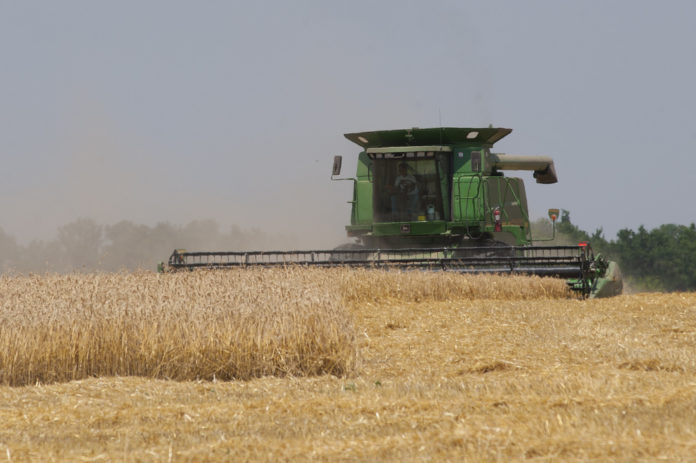Tariff relief has brought at least $10 million to Kansas farmers battling the fallout from the U.S. trade war that battered agriculture commodity prices last year.
Payments from the Market Facilitation Program went to about 9,400 farmers across Kansas through Oct. 31, according to data collected by the Environmental Working Group.
The U.S. Department of Agriculture has said it does not have state-by-state breakdowns showing how the proceeds from the relief program were doled out.
It will only say that as of mid-December, about $2.4 billion was paid out, with Illinois, Iowa, Kansas, Minnesota and Nebraska getting the most money. The top commodities were soybeans, corn, wheat, dairy and sorghum
However, the Environmental Working Group used the federal open-records law to gain access to the names and addresses of every farmer receiving the subsidies as well as how much they received from the program.
The group’s information reflects only a snapshot in time and just a fraction of the overall payout, which could total up to $12 billion. The EWG data covered 87,704 payments totaling nearly $356 million through Oct. 31.
More money is expected to be distributed in the new year. Last summer, President Donald Trump said the first round in tariff relief would be about $4.7 billion in payments to farmers.
A second round is expected to bring the payout to about $9.6 billion, although those payments could be affected by the ongoing government shutdown.
The Sunflower State Journal examined the EWG data, which has been used in other newspaper reports nationally, to determine how much is coming to Kansas and for what commodities.
The numbers reveal that the average Kansas farmer has received about $1,079. Most of the money coming to Kansas went for wheat ($5.5 million), soybeans ($2.9 million), sorghum ($756,000), hogs ($586,000), dairy ($345,000) and corn ($121,000).
The states with the biggest payouts — according to the EWG data — included Illinois ($63.8 million), Minnesota ($43.9 million), Iowa ($31.6 million), Nebraska ($26.1 million), Indiana ($19.9 million), South Dakota ($19.8 million), Ohio ($14.6 million) and North Dakota ($13.2 million).
Kansas had completed its wheat harvest earlier in the year, which experts said explains why that commodity received more than other commodities last year.
That could change this year because inclement weather delayed the soybean harvest until later in 2018.
The payments are intended to head off the effect of the country’s trade war with China, which is the biggest consumer of U.S. soybeans and soybean oil.
Deutsche Bank reported in November that soybean exports to China were down 98 percent, a trend that is affecting commodity prices in Kansas.
Last February, Kansas soybeans were selling at $9.19 a bushel, according to USDA data. By October, the price had dropped to $7.92 a bushel.
The price of wheat had dropped from $5.02 a bushel in June to $4.81 in October. Sorghum was selling at $5.46 per hundred pounds in October compared to $5.99 in February.
In the last year, the U.S. and China have imposed billions of dollars on each other’s products.
But last month, China agreed to a truce so the two countries could engage in negotiations with an eye toward ending the trade war.
There have been signs of warming trade relations. On Monday, it was reported that the Chinese made a third soybean purchase from the United States within the last month as the two countries participated in trade talks.
However, Trump has threatened to restart the trade war by March if the two countries can’t reach a deal.
The president has threatened to increase tariffs to 25 percent on $200 billion worth of Chinese goods if the talks falter.
Just to what extent the tariff relief program — capped at $125,000 per person or entity — has helped farmers is murky.
Experts say it largely depends on the size of the farm, the crop and the yield.
Hypothetically, a small producer of soybeans might receive more trade assistance than a larger producer who only grew corn, experts said.
The federal government, for instance, is paying farmers $1.65 a bushel for soybeans, compared to a penny a bushel for corn because soybeans are more impacted by the tariffs.
“This will help farmers’ income some,” said Dan O’Brien, an agricultural economist at Kansas State University. “It certainly varies by farm. It’s not a clear-cut answer.”

O’Brien said payments ranging somewhere between $5,000 and $15,000 or more would stand to help the average family-sized farm in Kansas.
The EWG data through October showed that about 500 soybean farms received tariff payments.
About 190 of those farms received at least $5,000, with payments ranging as high as $82,000.
About 230 sorghum farmers received tariff payments, with 39 receiving more than $5,000.
The data show that about 7,500 wheat farmers received payments. About 90 received more than $5,000.
The government paid wheat farmers 14 cents a bushel, compared to 86 cents for sorghum and $1.65 for soybeans.
“The more it is as a percentage of the overall farm income, the more important it is,” O’Brien said of the tariff payments.
“Is it enough to take and put it on their operating loan?” O’Brien said. “You need several thousand dollars to … make an impact on that operating loan.”
Farm relief payments are capped at $125,000 per person or entity, and applicants must have an average adjusted gross income for tax years 2014, 2015 and 2016 of less than $900,000.
“You have to be a pretty big farm for $125,000 not to make any difference,” O’Brien said.
U.S. Sen. Jerry Moran suggested that money from the tariff relief program will have a limited benefit for Kansas farmers.

“Kansas farmers and ranchers continue to feel the effects of this tit-for-tat tariff battle,” Moran said in a statement.
“These payments will provide short-term relief to producers harmed most by the tariffs, but no disaster package will be enough to cover the long-term costs of lost export markets.”
Charles Atkinson farms about 3,500 acres with his dad and his son in Cherokee County. The tariff payments helped the business stay even, he said.
“What it basically allowed us to do is pay our bills this year,” Atkinson said. “It didn’t recover our full market, but based on how much the tariffs were affecting our commodities, it helped narrow that gap.”
Glenn Brunkow farms corn and soybeans — along with cattle — on about 500 acres in Pottawatomie County.
While he hasn’t yet received a tariff payment, Brunkow said the relief program has given farmers a lift.
“It lessens the pain of the lowest soybean prices we’ve seen in years,” Brunkow said. “In the ag economy we’re in now, any little bit helps and makes life a little easier.”
Bottom line: Farmers don’t want to depend on aid from the government, Brunkow said.
“This is nice and it helps and it’s a Band-Aid, but we still want free trade,” he said. “We’d rather sell $10 (a bushel) beans on our own rather than have this relief.”
Republican U.S. Sen Pat Roberts said free trade is the solution for the state’s farmers.
“Every dollar coming in is helpful,” Roberts said in an interview. “We don’t want aid, we want trade.”

Justin Knopf operates a 4,200-acre farm in eastern Saline County with his dad and brother. They grow wheat, soybeans, sorghum, corn and alfalfa.
He hasn’t completed an application for relief yet, but he expects the program will affect the profitability for soybeans and will have a negligible effect on what he farms in corn and wheat. Corn and wheat pay less than soybeans and the yield for the other crops were lower for 2018.
“It certainly will not be a difference between whether we farm another year or not,” Knopf said.
“There are enough challenges right now economically on farms to where every little bit would help,” he said.
“Because margins are so tight right now on farms, it’s enough to make a difference, and it’s worthwhile.”
He praises the federal government for recognizing the plight farmers face with the international trade dispute.
“It matters to me that they realize there’s been a real economic impact on farms across the heartland.”













